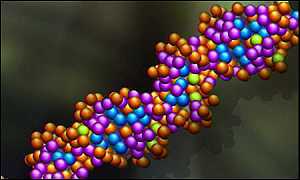

June 26, 2000 - BBC
In a breakthrough likened to a medical version of putting man on the moon, two teams of scientists have completed a rough draft of the human genetic code - nature's instructions for making and maintaining human beings.
President Clinton, joined at the White House announcement Monday by British Prime Minister Tony Blair, who appeared by satellite transmission, hailed completion of the work "a day for the ages" after a 10-year race that cost billions.
Clinton, who had helped calm a bitter rivalry between public and private groups racing to complete the genome map, beamed with pride at the announcement before a large gathering at the White House.
"Today we are learning the language in which God created life," Clinton said. "We are gaining ever more awe for the complexity, the beauty, the wonder of God's most divine and sacred gift."
He called the achievement a "day for the ages," and likened it to Galileo's celestial searchingšs and the mapping of the American wild by explorers Lewis and Clark. He also cautioned that the genetic map must never be used to segregate, discriminate or invade the privacy of human beings.
Francis Collins, head of the Human Genome Project of the National Institutes of Health, said the breakthrough allows humans for the first time to read "our own instruction book. Today, we celebrate the revelation of the first draft of the human book of life."
Said Blair: "Let us be in no doubt about what we are witnessing today: A revolution in medical science whose implications far surpass even the discovery of antibiotics, the first great technological triumph of the 21st century."
At a press conference in London, hours ahead the one scheduled here, the Human Genome Project announced that scientists had decoded the 3.1 billion sub-units of DNA, the chemical "letters" that make up the recipe of human life.
The chemical mapping of more than 90 percent of human DNA, seen as one of history's great scientific milestones, has been a keen fight between the Human Genome Project and the private company, Celera Genomics, of Rockville, Md.
"I am happy that today the only race we are talking about is the human race," Collins said.
Investors were mixed on the announcement. Shares of Celera fell $14.50 to $110.75 after moving as high as $135 in trading Monday on the New York Stock exchange.
To map the human genome, the publicly financed Human Genome Project and the parallel private effort by Celera had to decipher some 3.1 billion sub-units of DNA, the chemical letters that code biological workings of humans.
Within the DNA there are an estimated 50,000 or more genes. These determine what a person inherits from parents and how well the cells function through out a lifetime. Flawed or missing genes can cause disease.
Mapping the entire human genome is seen as one of history's great scientific milestones, the biological equivalent of the moon landing.
Now, "the real work begins," said Collins.
"We've been racing down white water in a narrow channel trying to get the sequencing done," Collins said in an interview. "Now we're opening into the ocean" where the research possibilities and the effects on medicine are almost limitless.
"There is a very long list of things that we can now do, all of which will greatly benefit medicine," said Collins. Researchers now will concentrate on finding disease-causing genes and developing therapies that treat disorders at the fundamental, molecular level.
In London, Dr. Michael Dexter of Britain's Wellcome Trust, a part of the public project, said: "Mapping the human genome has been compared to putting a man on the moon. But I believe that in terms of the future impact on society, the human genome project will be seen as the outstanding achievement, not only of our lifetime, but perhaps in the history of mankind."
Dexter said the research should be available to all - an apparent jibe at the head of Celera, American scientist-entrepreneur J.Craig Venter, who has made no secret of wanting to profit from the discovery, possibly by patenting it. "It should not be owned by one individual, one company, or one country," Dexter said.
Venter, appearing alongside Clinton and Collins in Washington, said his company mapped the genetic codes of five people - three women and two men - of different races. Venter said scientists studying the maps were unable to tell one ethnicity from another.
"What we've shown is the concept of race has no scientific basis," Venter said.
The scientists said 2,000 people die daily from cancer. By mapping the genome, there is at least the possibility of reducing that toll to zero.
Scientists believe that eventually medicine will be able to identify from birth the diseases that a person may develop and to provide treatment to extend life and health beyond what was ever possible before.
"It's a giant resource," said James D. Watson, the American scientist who won the Nobel Prize for Physiology for his work in discovering the double-helix structure of DNA in the early 1950s.
"Now we have the instruction book for human life and will have the instruction books for many other forms of life," Watson said in a telephone interview with British Broadcasting Corp. radio.
"Things are just going to move faster. After the printing press, there was an explosion, more people could have information. We'll understand ourselves better, have a better idea of what human nature is."
"The information obtained from the generic blueprint will have major implications for understanding disease processes - especially cancer," said Sir Paul Nurse, director general of the Imperial Cancer Research Fund.
The public project is a joint effort of agencies of the American National Institutes of Health, the Department of Energy, several universities and the Wellcome Trust in England. Researchers in Germany and Japan also participated.
Researchers now will turn their attention toward identifying the proteins made by the genes. This research will determine the function of about a million proteins in the body and then devise therapeutic drugs. Researchers believe ultimately doctors will tailor treatment to individuals and even correct genetic flaws before birth.
May 9, 2000 - Reuters
Scientists announced Monday that they had deciphered the genetic code of chromosome 21 which will improve understanding of Down's Syndrome, Alzheimer's disease and a range of other disorders.
Chromosome 21 is the smallest of the 23 pairs of human chromosomes, with an estimated 225 protein-coding genes, and only the second to be completely deciphered.
A consortium of international scientists, led by German and Japanese researchers from the Institute for Molecular Biotechnology in Germany, and the RIKEN Genomic Sciences Center in Japan, mapped the sequence which is published in this week's edition of the science journal Nature.
``The complete sequence analysis of human chromosome 21 will have profound implications for understanding the pathogenesis of diseases and the development of new therapeutic approaches,'' the scientists said in the report.
The genetic map will help scientists develop more precise diagnostic tests and new treatments for diseases linked to the chromosome, including a particular type of epilepsy, auto-immune diseases and an increased susceptibility to leukemia.
``The challenge now is to unravel the function of all the genes on chromosome 21,'' the scientists added.
Human Gene Total Revised
The small number of genes on the chromosome and the 545 active genes in chromosome 22, which was sequenced last year, have also led the scientists to revise the estimated total number of human genes to 40,000 from 70,000 to 100,000 genes.
Up to a third of chromosome 21 contained no genes.
Both chromosomes are small, but together they make up two to three percent of the human genome, the basic blueprint of life.
Each chromosome is made up of a molecule of DNA in the shape of a double helix which is composed of four chemical bases represented by the letters A (adenine), T (thymine), G (guanine) and C (cytosine). The arrangement, or sequence, of the letters determines the cell's genetic code.
The scientists mapped out the 33.5 million base pairs of chromosome 21. The human genome contains three billion base pairs of DNA.
Step To New Strategy On Down's Syndrome
The achievement is particularly significant for the study of Down's Syndrome, which affects one in 700 live births. The complex disorder is caused by an extra copy of the chromosome.
``These are the tools to design strategies to identify the culprits, the genes, which are responsible for the pathogenesis of the disease,'' Marie-Laure Yaspo, of the Max Planck Institute fur Molecular Genetics in Berlin who led one of the research groups, said in a telephone interview.
``I would call it a tool box, where we have everything we would need to design novel strategies. We have to design novel strategies because the problem of Down's Syndrome is not a mutation. It is too much of something -- that is one more chromosome,'' she added.
In addition to Down's Syndrome, chromosome 21 is also linked to the early onset Alzheimer's disease, certain types of leukemia, a form of manic depression and congenital heart disease.
Nobuyoski Shimizu and scientists at Keio University in Japan and Helmut Blocker and researchers at the Corporation for Biotechnological Research in Brunswick in Germany as well as Swiss, French, American and British scientists contributed to the research.
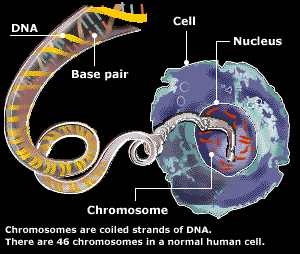
April 17, 2000 - BBC
Scientists have announced "rough drafts" of the genetic code stored on three human chromosomes.
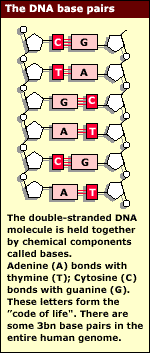
The news comes from the US-based Joint Genome Institute, which is part of a publicly-funded, international effort to decipher the complete set of biochemical instructions required to build and maintain the human body.
The chromosomes are numbered 5, 16 and 19. They are among 24 distinct bundles of DNA within our cells that contain the "code of life".
At the end of last year, the publicly-funded effort decoded chromosome 22, and a "working draft" of the entire set of chromosomes is promised by June.
The Joint Genome Institute researchers say they have mapped about 90% of the three chromosomes. The gaps, which will be filled in eventually, contain areas thought not to contain very important information.
Those areas that have been sequenced have an estimated 10,000 to 15,000 genes and comprise about 11% of a human's total genetic material. The researchers still have to order the code precisely and mark out the exact positions of the genes, the templates for the protein molecules that guide the form and function of cells.
Some of the genes on the newly mapped chromosomes contain defects that may predispose patients to certain forms of kidney disease, prostate and colorectal cancer, leukemia, high blood pressure, diabetes and the damage to arteries known as arteriosclerosis.
Public-private battle The news is just the latest in a series of announcements to come from the private and public sector initiatives involved in decoding the human genome. Each side has disputed the quality and progress of the work undertaken by the other side.
February 19, 2000 - AP - Wash.
Scientists at last have deciphered virtually the entire genetic code of the fruit fly, an important dry run in figuring out all the genes that make humans tick.
The achievement was announced Friday by scientists who took part in an unusual collaboration between a university lab and a private company that is racing the federal government to decode the human genetic library.
For almost 100 years, the fruit fly - known to scientists as Drosophila melanogaster - has been the premier lab species for learning how the appearance and traits of all living things are encoded in their genes.
Indeed, it was fruit fly experiments that led to the understanding that genes are carried in long strings called chromosomes.
In the latest project, scientists unraveled the fruit fly's genetic blue print from end to end. They decoded both the actual genes and the less interesting bits of genetic filler that separate them along the chromosomes.
The project combined the expertise of Dr. Gerald Rubin's Drosophila Genome Project Group at the University of California at Berkeley with the powerful gene-sequencing machines and computers at Celera Genomics Corp., the Rockville, Md., company headed by J. Craig Venter.
Scientists from both groups announced the results at the annual meeting of the American Association for the Advancement of Science.
They say they have unraveled more than 97 percent of the fly's genetic code and more than 99 percent of the actual genes. In all, it turns out that every fruit fly cell contains 13,601 genes. Human cells, by contrast, are thought to have about 70,000.
The scientists have lumped the fruit fly genes into broad categories, such as those that contain the code for enzymes or for structural proteins. The duties of half the genes are unknown.
Although about 1,600 tiny gaps still remain, Rubin said they are filling these in at a rate of about 100 a day.
Rubin said three scientific papers on the work have been submitted to the journal Science. Much of the raw data already are available on the Internet at the National Library of Medicine's GenBank site.
To those who have spent their careers studying the fruit fly, the data are likely to offer many insights as well as possibilities for new experiments. Among other things, Dr. Edward Lewis said it will mean scientists may spend as much time scrutinizing newly available genetic code on computer screens as they now do in lab experiments.
"We have been looking forward to this for a long time. It really is a big deal," said Lewis, a longtime Drosophila researcher at the California Institute of Technology.
One reason scientists study the genes of simple creatures like flies and worms is that similar genes often play important roles in the internal workings of people.
Rubin said his team looked at 289 genetic flaws known to cause diseases in humans. Using the new data, they searched for similar genes in the fruit fly and found that 60 percent of the human genes match up.
These include genes for such common human problems as kidney disease, Alzheimer's disease and cancer. In fact, 70 percent of the genes known to cause human malignancy were found to exist in similar form in the fruit fly.
Mark Adams, one of the Celera scientists, said a longtime goal has been discovery of a fruit fly version of a human gene called p53. This gene ordinarily corrects genetic errors, and defects in p53 are an extremely common contributor to cancer.
Using the new data, scientists found the gene.
Over the years, scientists have discovered many mutations that cause odd body shapes or unusual characteristics in fruit flies. Recently, a gene dubbed Methuselah was discovered that makes fruit flies live about one-third longer than usual. Adams said the new data show that the Methuselah gene actually is one of a large family, and it has 10 close relatives.
The Celera scientists used a method called whole genome shotgun sequencing. They decoded more than 3 million fragments of the fly's genes, then looked for overlapping chunks so they could piece them together into a continuous strand.
The National Center for Human Genome Research uses a different approach in the government-backed effort to learn the human genetic blueprint. Venter has proposed teaming up, although the timing of releasing data to the public has been a sticking point.
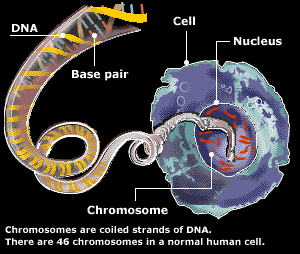
December 1, 1999 - BBC
An international team of scientists has for the first time mapped an entire human chromosome, one of the 24 distinct bundles of DNA within our cells that contain the genetic information to make a human being.
It is an historic first for the $3bn Human Genome Project (HGP), which seeks to unravel the hereditary instructions that make each individual unique. The project will produce a rough draft of the genome next spring, with a final and complete version in three to five years.
Understanding our genetic blueprint will revolutionize medicine, allowing doctors to treat a range of diseases that have hitherto been incurable.
The completed sequence for chromosome 22 announced on Wednesday could even lead to novel ways of tackling schizophrenia.
"This is the first time that we've had a complete chapter in the human instruction book, and that's pretty amazing," said Francis Collins, from the United States National Institutes of Health and who chairs the HGP.
"I think this is probably the most important scientific effort that mankind has ever mounted," he said. "That includes splitting the atom and going to the Moon."
Life code
The human genetic code, or genome, consists of three billion pairs of chemicals known as bases. Given the letters A, T, C and G, they form the central part of the DNA molecules that inhabit nearly all our cells. All human DNA in the nucleus of those cells is coiled and folded into structures called chromosomes.
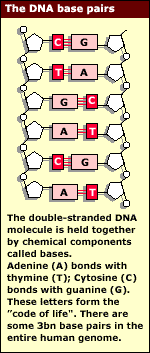
What HGP scientists have done is sequence the precise order of the bases in the DNA that makes up chromosome 22, the second smallest of our 23 pairs of chromosomes.
The researchers say the full sequence comprises more than 33 million base pairs. This includes at least 545 working genes - the distinct regions of sequence that code for the proteins that build and maintain our bodies.
Computer modeling suggests there may be as many as 1,000 genes on chromosome 22, but even this is but a small fraction of the estimated 60,000 to 100,000 genes in our cells.
Human disorders "One down, the others to go," said Ian Dunham, a biochemist at the Sanger Centre in Cambridge, UK, and lead author on the scientific paper in the journal Nature that announces the genetics landmark. "It's a great relief to have it finished."
Mutations to genes along chromosome 22 contribute to heart defects, immune system disorders, cancers, and mental retardation. A gene linked to schizophrenia is also thought to reside somewhere on chromosome 22.
"You will see buried in all sorts of papers that people have used the sequence already," said Dr Peter Little of Imperial College in London. He uses the information to study a protein on the surface of nerve cells.
Understanding these genes and how they work could lead to new drugs tailored to an individual's particular genetic details.
The Human Genome Project is competing with Celera Genomics, run by Craig Venter, to be first to publish a rough draft of the human genetic code. Scientists say that the human genetic map will be vast mine of data, equivalent to roughly half a million pages of information, that will take years to sift.
BIOLOGY INDEX PHYSICAL SCIENCES INDEX ALPHBETICAL INDEX OF ALL FILES CRYSTALINKS MAIN PAGE